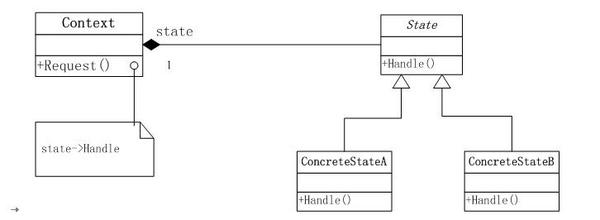设计模式(10)状态模式(讲解+应用)
目录
-
状态模式
-
为什么使用状态模式?
-
应用实例
状态模式
状态模式,顾名思义,肯定是和状态有关,进一步思考,我们在讨论的是设计模式,设计模式中的重要原则对变化的进行封装,顺着这个思路去想,那么是有很多的变化的状态,然后通过状态设计模式,来对这些变化的状态进行封装,故状态设计模式。
状态模式:对于对象内部的状态,允许其在不同的状态下,拥有不同的行为,对状态单独封装成类。
和策略模式类似,这里是将每一个状态单独封装成类,每个状态下拥有不同行为。
为什么使用状态模式?
为什么要使用状态模式?通过一个例子来看,对于一些问题,当我们通过一个例子将其具体化之后,我们会发现问题处理起来变得简单,同时理解起来也不会和之前那样晦涩难懂。通过什么来举例子呢?设计到多状态,不同状态下各自具有不同行为的东西,而且理解起来相对容易的。最近在地铁站发现了有个叫5个橙子的投币榨汁机,我们投币10元前,我们就可以获得一杯用5个橙子榨出来的橙汁一杯,如果让我们设计这套系统,要怎么设计呢?首先要有的feature,投币,退币,出橙子,然后其要有的state有没有钱币,10元钱币,大于10元的钱币,小于10元的钱币,橙子售空,还有橙子。动手来写。
//榨汁机 public class MillMachine{ //各种状态 final static int SOLD_OUT = 0; final static int SOLD = 1; final static int NO_MONEY = 3; final static int HAS_MONEY = 4; int state; int count; public MillMachine(int count){ this.count = count; if(count>0) state = NO_MONEY; } //插入钱币 public void insertMoney(){ if(state == HAS_MONEY) System.out.println("You can't insert Money"); else if(state == NO_MONEY){ System.out.println("You insert 10"); state = HAS_MONEY; } else if(state == SOLD_OUT) System.out.println("Nothing can be bought"); else if(state == SOLD) System.out.prinltn("You will get a cup of juice"); } //取出钱币 public void withdrawMoney(){ if(state == HAS_MONEY){ System.out.println("You will get Money"); state = NO_MONEY; }else if(state == NO_MONEY){ System.out.println("You haven't insert money"); }else if(state == SOLD){ System.out.println("You can't get back the money"); }else if(state == SOLD_OUT){ System.out.println("You haven't insert money"); } } //按下榨汁按钮 public void pressKnob(){ if(state == SOLD){ System.out.println("Please wait a minute,you will get a cup of juice"); }else if(state == SOLD_OUT){ System.out.prinltn("Sorry,three are't juice for you"); }else if(state == NO_MONEY){ System.out.println("Please insert Money"); }else if(state == HAS_MONEY){ System.out.pritln("You will get a cup of juice") state = SOLD; produce(); } } //产生果汁 public void produce(){ if(state == SOLD){ System.out.println("You get a cup of juice"); count--; if(count<0) state=SOLD_OUT; else state=NO_MONEY; }else if(state==SOLD_OUT){ System.out.println("Nothing"); }else if(state==NO_MONEY){ System.out.println("Nothing"); } else if(state==HAS_MONEY){ System.out.println("Nothing"); } } } 根据代码,我们可以看出,我们一共拥有四种状态,分别为有钱,没钱,售空,未售空。操作有按下榨汁按钮,插入钱币,取出钱币,榨汁,当然榨汁操作并不是我们手动可以触发的。对于其中相应的方法写的也比较详细,各个操作下状态的转换,根据上面的代码,我们可以看出是很繁琐的,而且一旦增加状态,或者是操作,需要我们修改很多的代码,灵活性和可扩展性很差,现在就到了我们的状态设计模式大显身手的时候了。既然是有很多的状态,不同状态下相同的操作行为不同,那么我们就将每一种状态单独封装成类,然后这些状态分别实现各自不同操作下的行为,这样我们的榨汁机只需要对几个状态对象进行操作就可以了,使得代码变得简洁也方便以后的修改.Show the code
public class MillMachine{ State noMoneyState; State hasMoneyState; State soldState; State soldOutState; State state; int count; public MillMachine(int count){ noMoneyState = new NoMoneyState(this); //..... this.count = count; if(count>0) state = NoMoneyState; } public void insertMoney(){ state.insertMoney(); } public void withdrawMoney(){ state.withdrawMoney(); } public void pressKnob(){ state.pressKnob(); } public void produce(){ state.produce(); } public State getNoMoneyState(){ return this.NoMoneyState; } public void setState(State state){ this.state = state; } } public interface State{ public void insertMoney(); public void withdrawMoney(); public void pressKnob(); public void produce(); } public class HasMoneyState implements State{ MillMachine machine; public HasMoneyState(MillMachine machine){ this.machine = machine; } public void insertMoney(){ //....... } public void withdrawMoney(){ System.out.pritln("you will get your money"); machine.setState(machine.getNoMoney()); } public void pressKnob(){ //...... } public void produce(){ //...... } } 通过这种方式来写,让我们的榨汁机类内部的代码量变得更加简洁,针对接口进行编程,同时带来一个弊端就是使得我们的额外的增加了许多的状态类,使得我们的代码量增加了很多。
应用实例
Android中的一个应用实例即使context和state之间,有兴趣的可以针对源码仔细了解,这里先贴出来。

用番茄钟计时来写这篇博客,用掉4个番茄。第五个也已经完成了一半,国庆之后,能有这么充足的时间再来写真的不容易了。
下篇更新适配器模式











![[HBLOG]公众号](https://www.liuhaihua.cn/img/qrcode_gzh.jpg)

